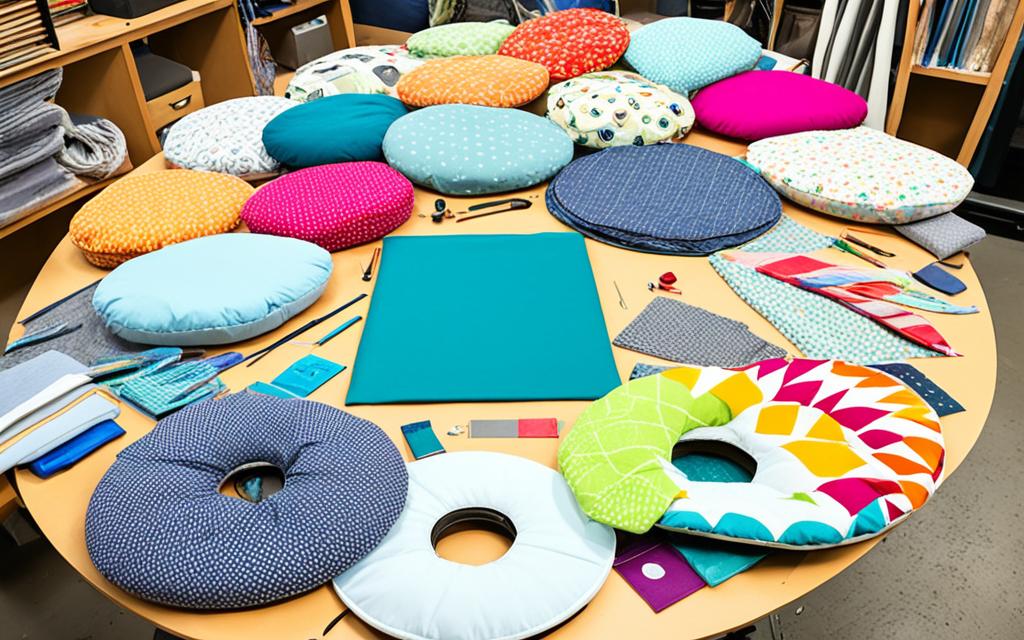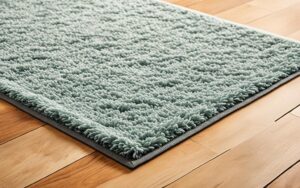Delving into the world of DIY home projects can be as fulfilling as it is practical. Today, I want to share my insights on crafting that perfect homemade papasan chair cushion.
Whether you’re an experienced crafter or just starting, this papasan chair cushion tutorial will navigate you through the process of creating a cozy and stylish addition to your home furniture collection.
With the focus on sustainability and cost-efficiency, the art of making a papasan chair cushion does not require extravagant spending.
As you follow my step-by-step guide, you’ll learn how to repurpose those old pillows you’ve almost forgotten about and transform them into a comfortable retreat.
My promise to you is not just an engaging journey in how to make a papasan chair cushion, but the pride and satisfaction that comes with handcrafted quality and personalized touch.
Gathering the Essentials for Your Papasan Chair Cushion
As I dive into the process of crafting a bespoke papasan chair cushion, the first step is selecting the right materials that will not only look great but will also stand the test of time.
Fabric choice is paramount – the right papasan chair cushion materials will define the durability and comfort of your cushion.
Through personal experience and many cushion crafting sessions, I’ve discovered that upholstery fabric or duck cloth deliver both resilience and style.
Choosing the Perfect Fabric and Materials
When it comes to crafting that plush seating, heavy-duty fabrics like canvas or upholstery-spec materials serve as a wise investment.
I always suggest picking a pattern or texture that resonates with your personal style, ensuring your papasan chair cushion pattern adds that touch of personality to your space.
Not forgetting the practical aspect, it’s essential to factor in the papasan chair cushion dimensions during this initial stage – a standard 60-inch width is a solid choice, providing that much-needed leeway for cutting.
Locating a Suitable Papasan Chair Frame
Without a doubt, a snug fit starts with the proper foundation. In searching for a papasan chair frame, make sure it’s sturdy and the right size for your needs.
It’s the skeleton upon which your cushion will rest, so getting this right is as crucial as the fabric itself. I’ve found that measuring the frame beforehand aids tremendously in visualizing the finished product.
Repurposing Old Pillows for Eco-Friendly Stuffing
Making an earth-friendly choice while being economical can be as simple as reusing old pillows to stuff your cushion.
Not only does this repurpose materials that might otherwise go to waste, but it also adds character and a touch of sustainability to your project. Remember, an eco-conscious craft is something to be proud of.
In anticipation of breathing new life into your papasan chair, my upcoming papasan chair cushion cover tutorial will guide you through each step with ease.
This undertaking is not just about creating a cushion; it’s about imprinting a piece of yourself into your home décor. Stay tuned, as I unravel the mystery of transforming simple materials into a comfort masterpiece.

How to Make a Papasan Chair Cushion: The Sewing Process Explained
Embarking on the journey of creating a cushion for your cherished papasan chair begins with measuring and crafting the correct pattern.
Attention to detail is critical, as precision will dictate the end comfort and functionality of your cushion.
For my DIY papasan chair cushion, I initiated the process by marking out a 52-inch diameter circle on the fabric to complement my 48-inch chair frame.
Adopting a homemade compass with just a shoelace, knitting needle, and sharpie allowed me to trace a perfect circle.
Creating the Cushion Pattern and Cutting Fabric Accurately
After sketching the papasan chair cushion pattern, the next step was cutting the fabric with precision. Accuracy is key to ensure that your cushion fits snugly onto the chair frame.
Ensuring the fabric’s pattern aligns and the papasan chair cushion dimensions are in check, I then proceeded to cut a second circle of the same size.
This would become the underside of the cushion, meaning both pieces need to align flawlessly for a seamless sewing experience.
Sewing Technique for Durable Seams
My sewing technique needed to be robust to withstand the wear and tear that comes with favorite lounge spots.
So, with my two fabric circles pinned together, fabric sides facing each other, I meticulously stitched around the edges, leaving a substantial opening for the stuffing.
This gap was crucial as it would allow me to invert the fabric to showcase the desired outward design and facilitate the filling process—a task that requires patience and attention to detail.
Inserting the Stuffing and Securing with Ties or Buttons
Once the sewing was complete, it was time to stuff this potential cloud of comfort.
I reached for those old pillows, now repurposed as eco-friendly fluff filling, and filled the cushion firmly to achieve a plush seating experience.
For a polished look and to prevent the filler from shifting, securing it with ties or buttons is an excellent option.
I decided to add a functional yet charming final touch by attaching a hidden zipper, offering the convenience of easy removal for washing.
Through this DIY papasan chair cushion endeavor, not only did I end up with a cozy nook, I also embraced the spirit of upcycling and personalized craftwork.
FAQ
Q: Choosing The Perfect Fabric And Materials
A: When selecting fabric for a papasan chair cushion, upholstery fabric or duck cloth is recommended due to its durability.
For regular fabrics, consider using heavyweight interfacing to reinforce the material. The fabric’s width should ideally be around 60 inches to provide ample room for pattern cutting.
Q: Locating A Suitable Papasan Chair Frame
A: Finding a papasan chair frame that fits your desired cushion size is crucial. Standard papasan chair frames are about 45-48 inches in diameter, so measure your frame to ensure your cushion will match perfectly.
Q: Repurposing Old Pillows For Eco-Friendly Stuffing
A: Repurposing old pillows for stuffing is an eco-friendly and cost-saving approach.
You’ll need to half them and shape them into wedges that fit snugly over the papasan frame. The amount needed will vary depending on pillow size and fluffiness.
Q: Creating The Cushion Pattern And Cutting Fabric Accurately
A: A 52-inch diameter circle pattern is typically suitable for a 48-inch papasan chair frame.
Use a homemade compass with a string and marker to draw an accurate circle on your fabric. Make sure to lay the fabric flat for precision.
Q: Sewing Technique For Durable Seams
A: The right sewing technique is key for durable seams. Pin two fabric circles together, right sides facing each other, and sew around, leaving a gap for stuffing.
Use strong, tight stitches and consider double-stitching for added strength.
Q: Inserting The Stuffing And Securing With Ties Or Buttons
A: Once the sewing part is done, turn the cushion cover right side out and begin stuffing it with the upcycled pillow wedges or other suitable materials.
After filling, close the gap with either hand basting followed by machine stitching or installing a zipper or buttons, which also makes the cover removable for washing.
Q: What Type Of Fabric Is Best For A Papasan Chair Cushion?
A: Upholstery fabric or duck cloth is the best for durability and long-term use. For lighter fabrics, use heavyweight interfacing for reinforcement.
Q: How Do I Measure My Papasan Chair Frame For A New Cushion?
A: Measure the diameter of the chair frame. Most frames will be around 45-48 inches across. Use this measurement to create a pattern for your cushion.
Q: Can I Use Old Pillows As Stuffing For My Papasan Chair Cushion?
A: Absolutely! Old pillows can be repurposed into stuffing wedges, which is an eco-friendly approach and helps to reduce waste.
Q: How Large Should My Cushion Pattern Be For A Standard Papasan Chair Frame?
A: For a standard frame about 48 inches in diameter, a cushion pattern should be 52 inches in diameter to allow for a proper fit and seam allowance.
Q: What Sewing Techniques Should Be Used To Ensure My Cushion Lasts Longer?
A: Use durable stitches like backstitch or a double stitch for the seams. It’s also beneficial to add ties or buttons for easy removal and cleaning of the cushion cover.
Q: Should I Use A Zipper Or Buttons To Close My Cushion, And Why?
A: A zipper or buttons are not only decorative but practical. They make the cushion cover easy to remove for washing, and in the case of buttons, can add a touch of design to your finished product.
Q: What’s The Best Way To Make Sure My Cushion Fits Snugly Over My Papasan Chair Frame?
A: It’s important to create a pattern that is slightly larger than the frame diameter, usually by 4 inches, and to pack your stuffing tightly to ensure the cushion sits snugly on the frame without slipping.









